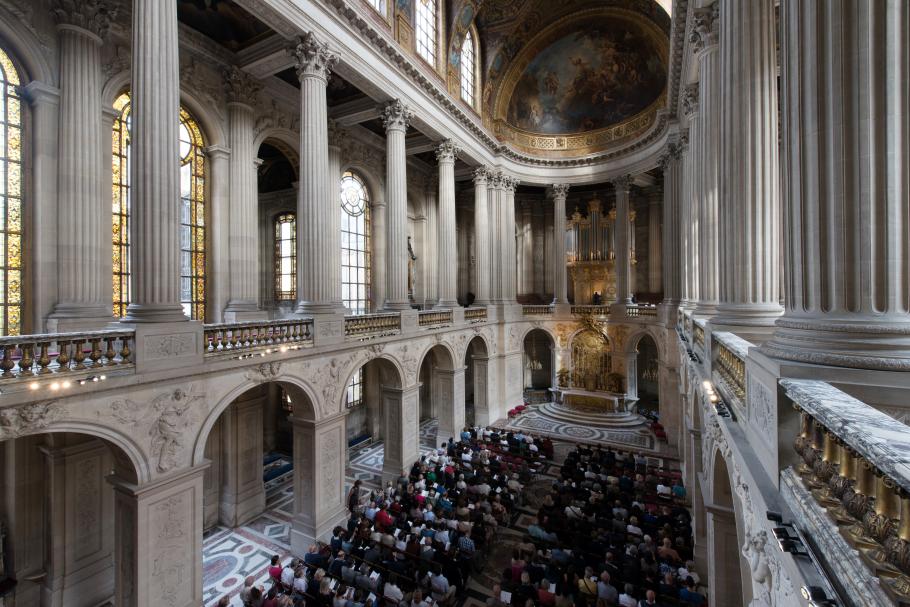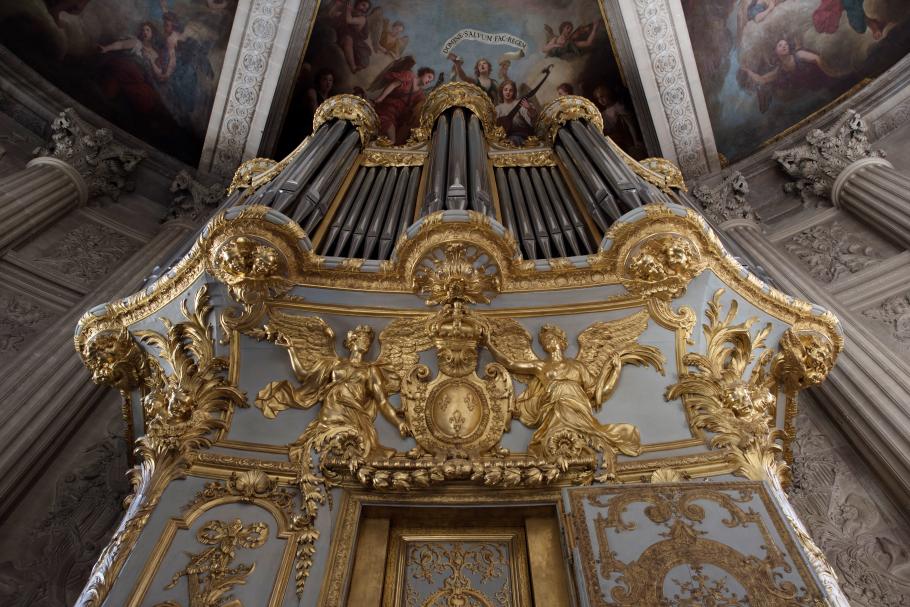Web series – The organ of the Royal Chapel sits on the gallery above the altar in a splendid array of gilding and sculpted decoration. Its fascinating history, which began in 1679 long before the construction of the final chapel, continues today thanks to the skilled hands of those who play and maintain it.
The Great Organ of the Royal Chapel
In the words of the experts...
This web series, comprising three episodes, gives voice to the people who breathe life into the Great Organ of the Royal Chapel.
It explains the musical context in which the organ was designed, its complex mechanisms and the process of its recent restoration.
Episode 1: Meet the four organists
This first episode introduces the four three-monthly organists of the Royal Chapel of Versailles: François Espinasse, Frédéric Desenclos, Jean-Baptiste Robin and Michel Bouvard. These exceptional musicians play what Louis XIV wanted to be “the most beautiful religious music in Europe”.
The relationship between the organist and the instrument is very personal. Michel Bouvard and Frédéric Desenclos had the fortune of discovering its unique sound thanks to their family heritage, while François Espinasse and Jean-Baptiste Robin tell of the privilege of playing in this history-laden venue and in the footsteps of celebrated musicians such as the young Mozart and François Couperin.
Episode 2: Meet the organ maker
In this second episode on the organ of the Royal Chapel, organ maker Bertrand Cattiaux explains the complex mechanisms of this wind instrument.
From an early age Bertrand Cattiaux was fascinated by the flow of music filling the church during mass. Faced with this magnificent instrument, his curiosity led him to discover a little-known profession guaranteed to provide unique expertise and consisting in maintaining and harmonising this large wind instrument.
Episode 3: Meet the Director of the Theatres
This episode with Jean-Paul Gousset, Director of the Theatres of Versailles and Project Manager for the restoration of the organ of the Royal Chapel of Versailles, relates the history of the successive restoration projects carried out on the organ and reveals the discoveries that marked its reconstruction by Betrand Cattiaux, Jean-Loup Boisseaux and Michel Chapuis.
This video was made in tribute to Michel Chapuis (15 January 1930-12 November 2017), who was an organist at the Royal Chapel of Versailles from 1995 to 2010.
History of the great organ
In 1679, Louis XIV commissioned an organ with two separate cases for the chapel (the third built at Versailles, the definitive one being the fifth) from the Parisian organ maker Étienne Enocq. From 1672 to 1682 the chapel occupied the location of what is now the Coronation Chamber on the first floor, and the first antechamber of the Dauphine on the garden level.
But the plans for the final chapel nearly twenty years later, which was Louis XIV's last building project, required a new organ with a single case to fit the design by the architect Robert de Cotte, who succeeded Jules Hardouin-Mansart. The casing was carved by Philippe Bertrand, while the instrumental part was made by organ makers Julien Tribuot and Robert Cliquot using plans drawn in 1679 by Étienne Énocq. Robert Cliquot was made “Royal Organ Maker” and was considered the most important French organ maker from 1700 to 1720.
On 5 June 1710, the fifth chapel was consecrated and the organ was inaugurated by François Couperin. The instrument is, unusually, located above the altar so that it faced the gallery where the royal family sat to attend mass. The casing of the organ was listed as an "object of historic monuments" in 1882, which also formalised the protection of the estate of Versailles.
After the death of Louis XIV in 1715, the instrument underwent certain modifications. It was restored several times by the descendants of Robert Clicquot and its composition was altered in 1736 by the organ maker Louis-Alexandre Clicquot, and again in 1762 by François-Henri Clicquot.
The composition of French organs developed in the 17th and 18th centuries and the number of stops increased. When François-Henri Clicquot rebuilt the organ, he reproduced the organ range from 1679 but removed the Vox Humana from the Echo as well as the mutation stops and added new ones.
The organ in the Royal Chapel was narrowly rescued from being sold during the French revolution by Jean-Louis Bêche, a former musician of the Royal Chapel, and the organ maker Jean Somer. The royal emblems were removed in 1794.
Restoration of the organ prior to its latest reconstruction
During the 19th century the organ underwent various repair and maintenance works, as well as certain modifications which altered its original condition. Two major restoration projects were carried out, one in the second half of the 19th century and the other just before the outbreak of the Second World War.
The first was by Aristide Cavaillé-Coll in 1872, who aspired to a Romantic organ in accordance with the aesthetic trends of the time but retained the casing.
The second project was by Victor Gonzalez in 1935 in the Neoclassical style and was commissioned by the French Organ Commission. These restoration projects were deemed to lack authenticity with regards the organ’s original condition, and the instrument was entirely disassembled in 1989. It was scrupulously rebuilt according to Clicquot’s design, based on its condition in 1710, by Jean-Loup Boisseau and Bertrand Cattiaux in 1994.
The current organ was inaugurated on 18 and 19 November 1995 by Michel Chapuis.
J.-P. Decavèle, The reconstruction of the organ of the Palace of Versailles, in [Inaugruation booklet]
Palace of Versailles. Inauguration of the organ of the Royal Chapel, 17, 18 and 19 November 1995.







